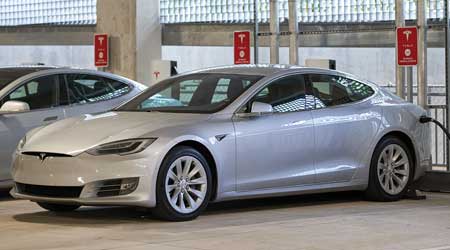New Era of Utility Incentives: EV Charging, Energy Storage
Utility incentives for technologies like electric vehicle charging stations and energy storage are gaining swift momentum. Here's how FMs can best take advantage.
In California, the three largest investor-owned utilities (Southern California Edison, San Diego Gas & Electric, and Pacific Gas and Electric) have approved $1 billion in utility investments for charging stations for electric cars, trucks, buses, airport equipment, cranes, and the like, says Max Baumhefner, senior attorney for the climate and clean energy program at the Natural Resources Defense Council. “There are programs that target workplaces, apartment complexes, multifamily housing locations, and any other places where people will be parked for a long time so you can get a good charge,” Baumhefner says. “There’s a whole host of programs trying to provide charging infrastructure for bigger vehicles, such as delivery trucks, school buses, and transit buses.” Similar programs have been approved across the nation, says Baumhefner.
Another $1 billion in programs is additionally being considered by the California Public Utilities Commission, inclusive of infrastructure at workplaces, multi-unit dwellings, and other long-dwell-time locations. In such instances, the utilities install the electrical infrastructure, and most programs issue a rebate to the customer for purchasing the charging stations. “Sometimes the utility owns the whole thing, particularly in segments where it has been difficult to get people interested, such as apartment complexes with few charging stations or in disadvantaged communities,” Baumhefner explains. Sometimes larger rebates are available for underserved markets, in which half or all the cost for a charging station is covered by a rebate.
Nick Nigro, founder of Atlas Public Policy, says that the tent for transportation electrification is getting much bigger, expanding from passenger vehicles to medium- and heavy-duty trucks and buses. According to Nigro, the investor-owned utility market provides incentives for charging stations, education, and even vehicles in some cases. “These programs are diverse, widespread, and cover most regions of the country. Last year about 40 filings or proposals were initiated across the country, by 19 utilities, in 10 states,” Nigro says.
Baumhefner says the rapid growth of the EV (electric vehicle) market has pushed more workplaces to deploy charging stations, which in turn encourages people to buy more EVs. Installing charging stations at workplaces makes sense because that is where cars are parked for the longest period of the day outside the home. “EVs are big batteries on wheels, and they can help soak up solar generation, but only if they are plugged in when the sun is shining,” Baumhefner says. Sometimes grid operators may get more solar energy during a particular time period than they can use and have to spill or waste it. Baumhefner says that while some excess can be stored in batteries, cars serve as effective batteries on wheels that can soak up the excess solar and wind energy when they are parked for long periods of time.
While only a small number of transit buses in the United States run on clean energy, their numbers are growing at a far greater rate than passenger vehicles. “The State of California has adopted rules that will ensure all new transit buses will be zero emission buses, and we know we can get there because it’s been done in Shenzhen, China, a city the size of New York, whose 17,000 buses are 100 percent electric,” Baumhefner says. California is also looking at new regulations for truck categories. “Most ripe are delivery vehicles, with a known duty cycle, fixed routes, and stop-and-start driving.” The electric power train used in buses can be adapted to other types of large vehicles, and in that sense the bus is a “beachhead” from which other vehicle categories will follow.
Use rates for charging stations vary by time of day, so people or companies can save money by charging during the hours of the day when the electric grid is underutilized. “On average, driving on electricity is the cost equivalent of driving on a dollar gallon of gasoline,” Baumhefner says, “and if you charge during off-peak times, it could be a lot cheaper, although that varies from state to state.” While large businesses that use a lot of energy take out expensive insurance policies with big banks to hedge against the volatility of oil prices, “they would do better to lock in a dollar a gallon equivalent of clean fuel,” Baumhefner says.
With transportation electrification, policymakers are promoting “good loads,” or “electricity that is beneficial to the economy and the environment,” says Nigro. Specifically, adding electric vehicles to the power grid, if the grid moves to renewable power sources, lightens the load of what is needed in the way of nonrenewable resources. At the same time, EVs can potentially draw most of their energy from renewable resources.
An example of a “good load” outside of transportation is building electrification, although this is on a smaller scale.
Nigro says that governments in states and cities are actively increasing their support for transportation electrification, and the Volkswagen settlement has come along at an opportune time. Volkswagen pleaded guilty to installing “defeat devices” in their vehicles which allowed them to pass emissions standards tests in the United States, when their vehicles were in fact emitting up to 40 times more pollution than was allowable. As part of the settlement, Nigro says, $2 billion from Volkswagen is being spent to build electric infrastructure. Another $2.9 billion from Volkswagen is being distributed to the states to spend on emission reduction activities — including the electrification of trucks and buses and the creation of electric vehicle charging stations.
“There is a lot of opportunity for building owners beyond charging infrastructure,” Nigro says. For example, companies that own vehicles might want to explore electric utility programs aimed at private fleets of vehicles.
Policy makers will continue to grapple with whether ratepayer or taxpayer dollars are well spent in providing incentives for people and businesses to buy new technology or whether they would have bought it anyway, says Feldman. “But if you look broadly at solar energy over the past 15 years,” he says, “you can make the strong case that there was a significant uptick in solar technology as a result of those rebates.” For now, incentives for newer technology remain important.
Energy storage incentives
A variety of energy storage technologies, from the large scale “pumped hydro” at the utility level to the lithium batteries of all shapes and sizes used by smaller scale businesses, are creating new opportunities for energy savings and related incentives.
Sometimes facilities install solar and energy storage technology at the same time, says Feldman, to capture the excess energy from solar. A reduction in high-cost, peak-demand energy in commercial buildings can be accomplished by drawing on energy in storage devices.
Incentives for storage may be for “upfront capital costs, but also are sometimes performance-based incentives,” says Feldman. The utility puts a meter on the energy storage system and measures how it is performing and pays the customer on that basis. “Some states have put in requirements for utilities to purchase a certain amount of energy storage from customers,” Feldman says.
California, Massachusetts, and New York have energy storage mandates, which require utilities to purchase a certain amount of energy storage from their customers.
Maryellen Lo Bosco is a freelance writer who covers facility management and technology. She is a contributing editor for Building Operating Management.
Related Topics:













